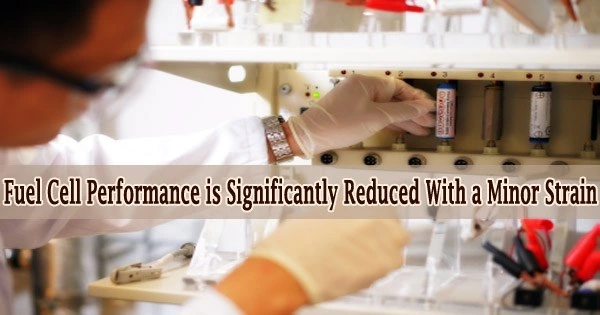The influence of strain on performance in working relationships is undoubtedly something that many of us are all too familiar with, but a recent study suggests that materials in electricity-generating fuel cells may be susceptible to strain on a completely different level.
The strain that just a 2% decrease in the space between atoms causes when it is deposited on a surface results in a whopping 99.999% decrease in the rate at which the materials conduct hydrogen ions, significantly lowering the performance of solid oxide fuel cells, according to researchers from Kyushu University.
The future availability of high-performance fuel cells for the generation of clean energy in more homes will be aided by solutions being developed to lessen this strain.
Fuel cells use an electrolyte to move the ions created by severing hydrogen or oxygen molecules from one side of the device to the other. This allows them to produce electricity from hydrogen and oxygen while discharging only water as “waste.”
Despite the fact that the word “electrolyte” frequently makes people think of liquids and sports drinks, they can also be solids. Electrolytes based on ceramics and solid oxides, which are hard materials made of oxygen and other atoms that conduct positive hydrogen ions, often known as protons, are of great interest to researchers for use in fuel cells.
Such proton-conducting solid oxides may work in middle temperature ranges of 300 to 600 °C, which is lower than their oxygen-ion-conducting counterparts. They are also more durable than liquids and polymer membranes.
Properties of individual materials are often measured in a condition where they are free of influence from surrounding layers what we call the bulk. However, when an oxide layer is grown on a surface, its atoms often have to readjust to accommodate the properties of the underlying surface, leading to differences from the bulk.
Junji Hyodo
“One key for good efficiency is to get the protons through the electrolyte to react with oxygen as quickly as possible,” says Junji Hyodo, author on the study and research assistant professor at the Kyushu University Platform of Inter-/Transdisciplinary Energy Research (Q-PIT).
“On paper, we have materials with great properties that should lead to excellent performance when used in solid oxide fuel cells, but the actual performance tends to be much lower.”
Now, the scientists believe they understand why after looking at what takes on where the electrolyte and reaction-inducing electrodes interact.
“Properties of individual materials are often measured in a condition where they are free of influence from surrounding layers what we call the bulk. However, when an oxide layer is grown on a surface, its atoms often have to readjust to accommodate the properties of the underlying surface, leading to differences from the bulk,” explains Hyodo.
The yttrium, barium, zirconium, and oxygen atoms that make up the promising oxide known as BZY20 were the main focus of the investigation. As the oxide develops, BYZ20 crystallizes into a common cube-shaped crystal that is replicated again on the surface.
The atoms on the edges of this cube are 2% closer at the oxide-to-surface interface than in layers distant from the surface, according to their analysis of samples of varied thicknesses. Additionally, this compressive strain causes the proton conductivity to drop to around 1/100,000 of its bulk sample value.
“A change of just 2% from one meter to 98 cm on a large scale might sound insignificant, but in a device where interactions happen on an atomic scale, it makes an enormous impact,” observes Yoshihiro Yamazaki, professor at Q-PIT and adviser on the study.
This compressive strain slowly decreases as the layers are added, and the cube eventually reaches its ideal size far from the interface. Away from the surface, conductivity may be high, but the harm has already been done.
The results of accounting for this decreased conductivity when calculating expected performance correspond with the results of actual fuel cell performance, showing that the strain is probably a factor in lowering performance.
“While we have good individual materials, maintaining their properties when combining them in a device is critical. In this case, we now know that strategies to reduce the strain where the oxide meets the electrode are needed,” says Yamazaki.





